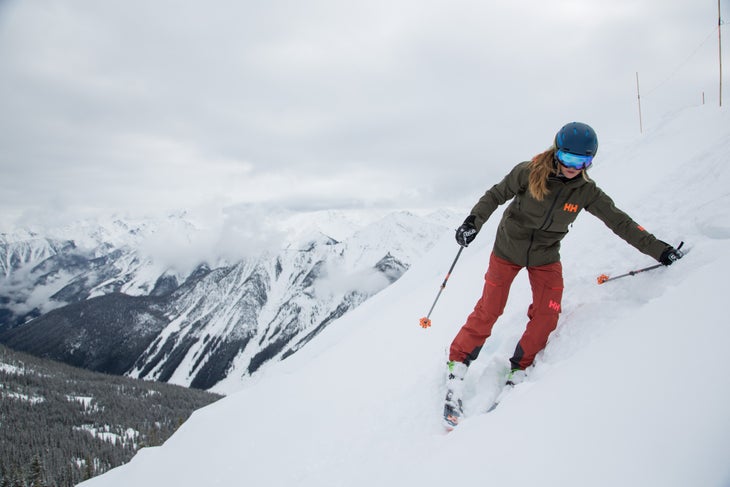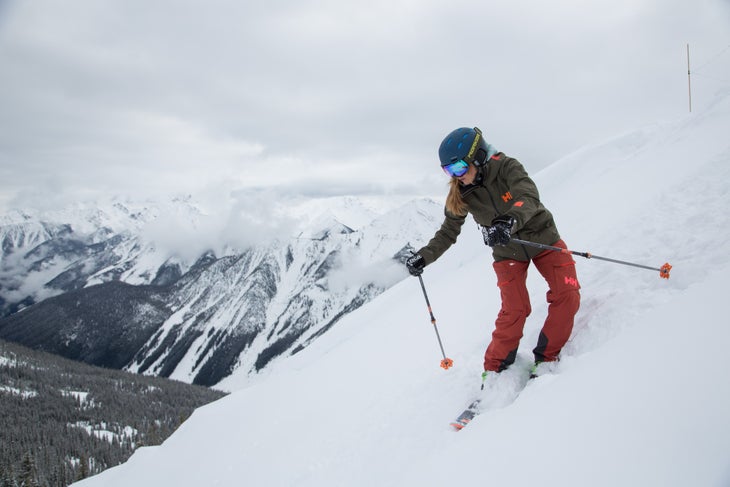Products You May Like
Get full access to Outside Learn, our online education hub featuring in-depth fitness, nutrition, and adventure courses and more than 2,000 instructional videos when you sign up for Outside+
Sign up for Outside+ today.
Stuck in a skills rut? Check out SKI’s online education courses on Outside Learn, home to hundreds of video tutorials. Get expert tips on how to level up from industry pros like Glen Plake, Wendy Fischer, Daron Rahlves, and more.
How do you measure steep? A resort map rating, a clinometer number, the quaking of your knees, the adrenaline rush?
However you quantify it, a gnarly slope is relative to your ability and/or risk aversion. As Chris Davenport said, “If I have to think twice before dropping in, it’s steep for me.”
Whatever your “steep,” tackling higher-angle terrain requires specific techniques and tactics. We caught up with Eric Lipton, instructor of SKI’s Mastering Steeps course shot on location in Kicking Horse, B.C., to get the low—er, high—down on steep skiing.
Watch: SKI’s Mastering Steeps course on Outside Learn
SKI Magazine: What’s the biggest mistake skiers make when tackling tough, steep lines?
Eric Lipton: The most common mistake I see skiers make in the steeps is skiing too defensively—leaning back and on their uphill ski. Keep your body and eyes focused downhill and put weight on your outside (downhill) ski. This is a much more offensive stance. Steep terrain rewards skiers who are playing offense, not defense.
SKI: How do you know when a skier is ready (or not ready) to ski steeper, more advanced terrain?
Lipton: First and foremost, a skier needs to be in the right mindset, and wanting a new challenge. If a skier is enjoying intermediate, low-angle terrain and is not interested in pushing their limits, that’s A-OK, and I would never force it. Skiing is personal and it’s about enjoyment. Everyone enjoys different aspects of the sport. Technically, a skier needs to feel in complete control on shallower slopes, that they can maneuver their equipment skillfully, as well as adjust their turn size and speed up or slow down as the conditions and terrain call for.


SKI: What’s your favorite steep run or most memorable steep line you’ve skied?
Lipton: I’ve got a lot of favorites. I run all-mountain ski camps in Portillo, Chile during August and we ski awesome steeps like Roca Jack, Cara-Cara, and Garganta. In the U.S., some of my favorite long, steep lines are from the top of Lone Peak at Big Sky in Montana.
SKI: What can skiers learn from watching pros like Kaylin Richardson (and you) on steeps?
Lipton: There is a lot of wisdom to glean from watching great skiers. Of the more easily identifiable things to watch, look at the upper body; it’s stable and relatively quiet. There won’t be a lot of extra movement in the arms or shoulders—no extra stuff going on. This is hard for many skiers to grasp because they think that swinging the arms and shoulders around erratically is a style thing, when it really is just taking them out of balance continuously.
A more subtle aspect of watching great skiers on steeps is how they edge the skis. Getting the best performance out of the skis is about finding the right edge angle, not necessarily the most edge angle. Many skiers think that more edge is always better, but on steep terrain with often varied snow conditions, that is definitely not true.
SKI: Whoops. When a skier gets in over their head on a too-steep run, what should they do?
Lipton: There are some critical skills that skiers need before venturing into high-angle terrain just in case this happens. Sideslipping in a corridor is one of them. A good slideslip can get you down some of the most harrowing terrain. Another is the kick-turn, which allows you change the direction you are facing without losing any elevation. It’s just the right move if you wind up faced toward gnarly terrain, like a cliff or narrow chute that you don’t have an appetite for. We teach both of these skills in the Mastering Steeps course.
We went to great lengths to break down the movements and skills needed for successfully conquering steep terrain in this course. Whether it’s smart tactics, like how to choose your line, or drills to hone your technique for your steep skiing endeavors, or different take-off techniques when catching air, I’m confident that a skier of any skill level can derive some insights from this course.
Check out the complete Mastering Steeps online course, taught by Eric Lipton and pro big mountain skier Kaylin Richardson.
